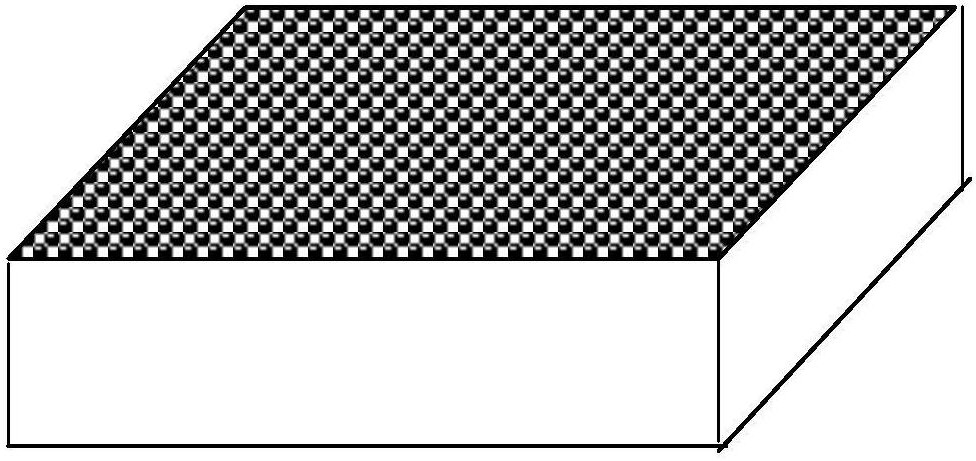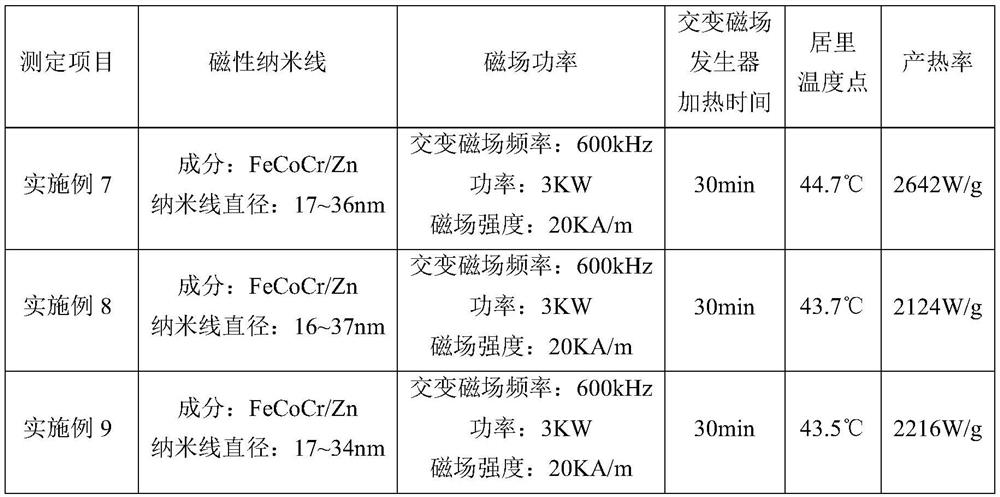Self-temperature-control magnetic nanowire and preparation method thereof
A magnetic nanometer and self-temperature control technology, which is applied in chemical instruments and methods, pharmaceutical formulations, medical preparations containing active ingredients, etc., can solve the problems of low heat generation and agglomeration of magnetic nanoparticles, and achieve quality controllable, Effects of preventing agglomeration and improving heat production rate
- Summary
- Abstract
- Description
- Claims
- Application Information
AI Technical Summary
Problems solved by technology
Method used
Image
Examples
Embodiment 1
[0034] A method for preparing self-temperature-controlled magnetic nanowires, comprising the steps of:
[0035] Step 1, the aluminum foil is anodized twice to make an aluminum anodized microporous template;
[0036] Step 2, depositing zinc-cobalt-chromium ferrite hydroxide in the microchannels of the aluminum anodic oxidation microchannel template by chemical co-precipitation method, and forming zinc-cobalt-chromium ferrite magnetic nanowires after sintering;
[0037] Step 3: removing the aluminum anodic oxidation micro-channel template by corrosion, and performing surface hydrophobization treatment on the zinc-cobalt-chromium ferrite magnetic nanowires to prepare the self-temperature-controlling magnetic nanowires.
Embodiment 2
[0039] A method for preparing self-temperature-controlled magnetic nanowires, comprising the steps of:
[0040] Step 1. The aluminum foil is anodized twice to make an aluminum anodized microporous template:
[0041] Take thin aluminum foil with a purity ≥ 99.95%, the thickness of the thin aluminum foil is 0.05-0.1mm, the surface is polished and cut into 50mm×50mm squares, and the cut thin aluminum foil is immersed in H with a molar concentration of 0.1-0.5mol / L 2 SO 4 Carry out an anodic oxidation in an aqueous solution, the primary oxidation voltage is 24-57V, and the oxidation time is 5-20min; the aluminum foil after primary anodization is immersed in a mixed solution of phosphoric acid and chromic acid to remove the primary oxide film on the surface of the aluminum foil, phosphoric acid The mass concentration of phosphoric acid in the mixed solution with chromic acid is 4-5 wt%, and the mass concentration of chromic acid is 1.2-1.4 wt%.
[0042] Then the aluminum foil was...
Embodiment 3
[0047] A method for preparing self-temperature-controlled magnetic nanowires, comprising the steps of:
[0048] Step 1. The aluminum foil is anodized twice to make an aluminum anodized microporous template:
[0049] Take thin aluminum foil with a purity ≥ 99.95%, the thickness of the thin aluminum foil is 0.05-0.1mm, the surface is polished and cut into 50mm×50mm squares, and the cut thin aluminum foil is immersed in H with a molar concentration of 0.1-0.5mol / L 2 SO 4 Carry out an anodic oxidation in an aqueous solution, the primary oxidation voltage is 24-57V, and the oxidation time is 5-20min; the aluminum foil after primary anodization is immersed in a mixed solution of phosphoric acid and chromic acid to remove the primary oxide film on the surface of the aluminum foil, phosphoric acid The mass concentration of phosphoric acid in the mixed solution with chromic acid is 4.5-5.5 wt%, and the mass concentration of chromic acid is 1.3-1.5 wt%.
[0050] Then the aluminum foil...
PUM
| Property | Measurement | Unit |
|---|---|---|
| thickness | aaaaa | aaaaa |
| pore size | aaaaa | aaaaa |
| diameter | aaaaa | aaaaa |
Abstract
Description
Claims
Application Information
 Login to View More
Login to View More - Generate Ideas
- Intellectual Property
- Life Sciences
- Materials
- Tech Scout
- Unparalleled Data Quality
- Higher Quality Content
- 60% Fewer Hallucinations
Browse by: Latest US Patents, China's latest patents, Technical Efficacy Thesaurus, Application Domain, Technology Topic, Popular Technical Reports.
© 2025 PatSnap. All rights reserved.Legal|Privacy policy|Modern Slavery Act Transparency Statement|Sitemap|About US| Contact US: help@patsnap.com



